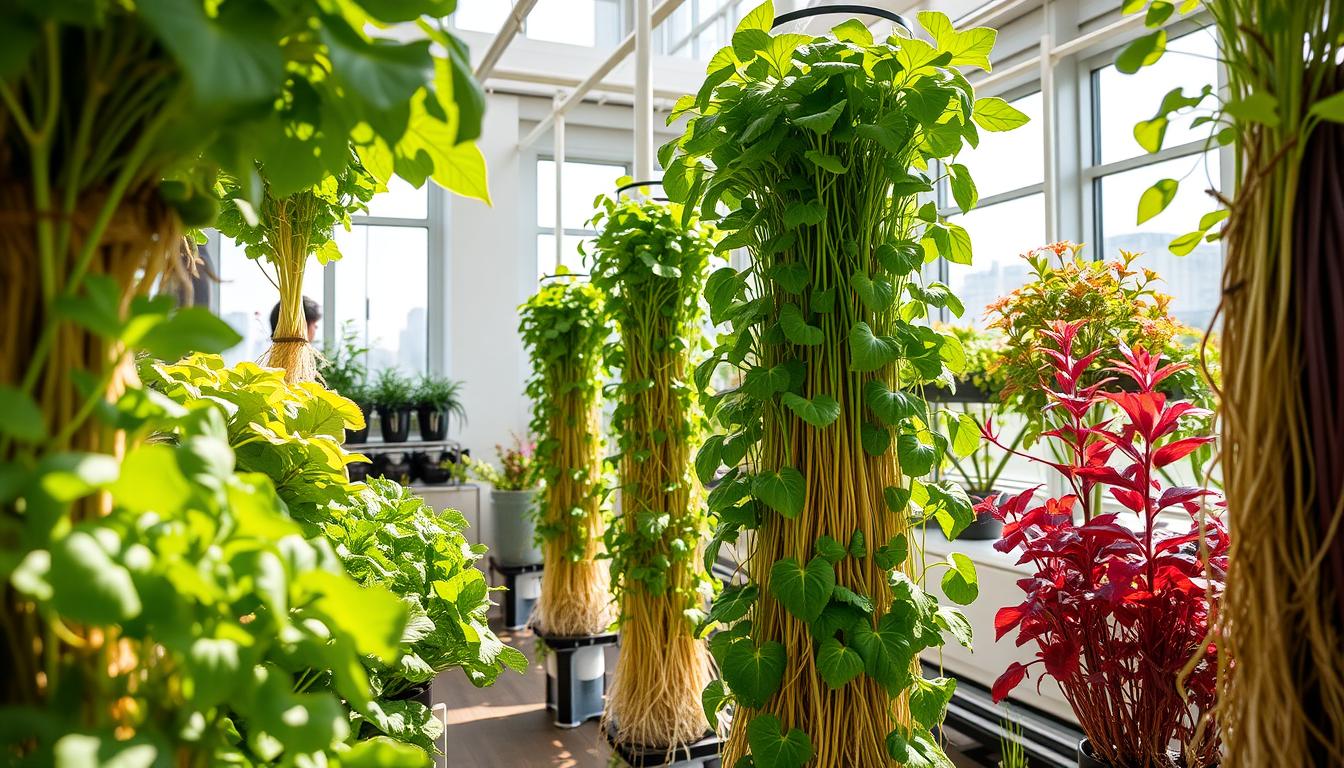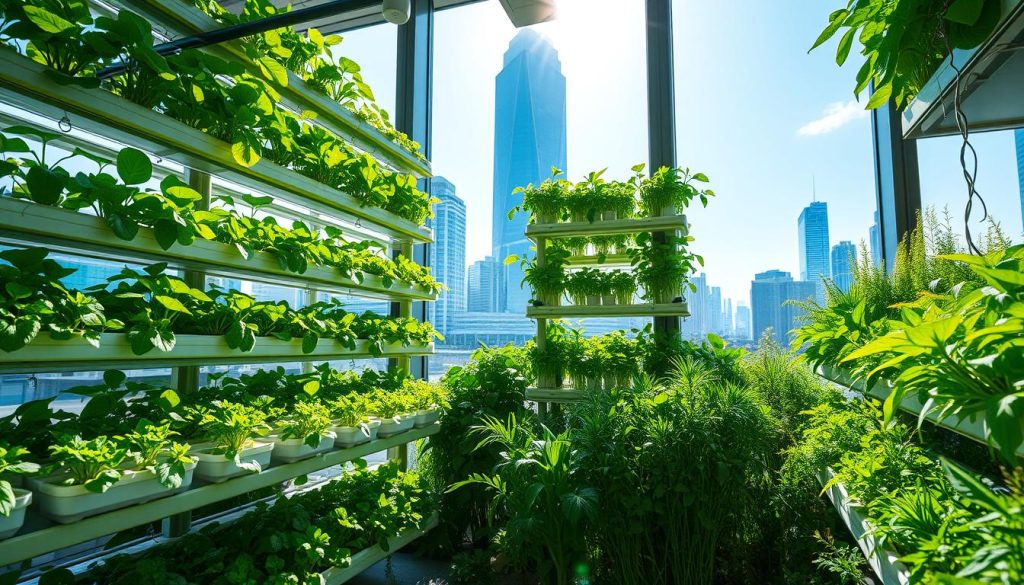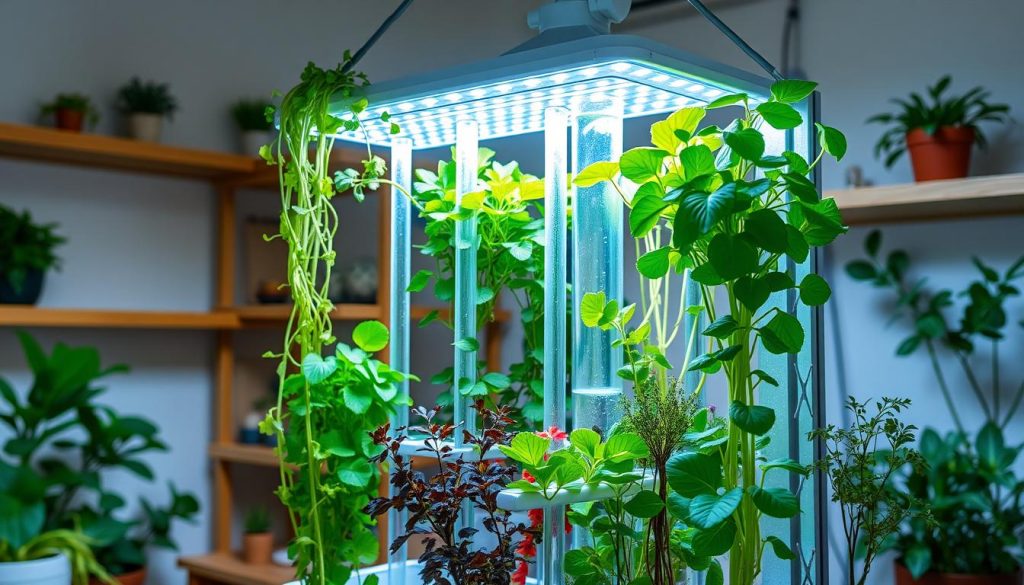Hydroponics: Grow More in Less Space

In today’s world, space is very valuable, especially in cities. Hydroponics is a new way to grow food without using soil. Instead, it uses a water solution full of nutrients to feed the plants.
This method makes plants grow faster and produce more than traditional gardening. It’s a game-changer for growing food in small areas.
Hydroponics can be used indoors or outdoors. It even works with artificial lights, allowing for growing all year round. This is great for city gardeners and small farmers who want to grow more in less space.
Whether you want to grow leafy greens, herbs, or vegetables, hydroponics is a smart choice. It’s efficient and versatile, making it perfect for any gardener.
Key Takeaways
- Hydroponics allows for faster growth and higher yields compared to traditional soil-based gardening.
- Hydroponic systems can be set up indoors or outdoors, providing year-round growing opportunities.
- Hydroponics is a space-efficient solution, perfect for urban and small-scale gardeners.
- Nutrient-rich water solutions feed the plants’ roots, eliminating the need for soil.
- Hydroponics can be a sustainable and water-conserving option for food production.
What is Hydroponics?
Hydroponics is a way to grow plants without soil. Plants get their nutrients from a water solution instead. This method works indoors or outdoors, perfect for small spaces or year-round growing.
Overview of Soilless Gardening
Soilless gardening, also known as aquaponics or plant factory, grows plants without soil. Plants’ roots soak in a nutrient-rich water solution. This method is efficient and saves space, great for city living or small farms.
Benefits of Hydroponic Gardening
- Faster growth and higher yields than traditional gardening
- Uses up to 10 times less water than soil-based gardening
- No weeds or pests, keeping the growing area clean
- Can grow plants all year, indoors or in controlled spaces
- Less environmental impact, using fewer pesticides
Hydroponics is a unique way to grow plants, from greens to fruits. Its benefits make it popular among gardeners and commercial growers.
Basic Components of Hydroponic Systems
Hydroponic gardening is a method that grows plants without soil. It’s great for small spaces and efficient growth. The main parts of a hydroponic system are the container, growing medium, and lights. Knowing these is key to a successful garden.
Containers and Growing Mediums
For small growers, a “Deep Water Culture” setup is simple. Plants hang over a tank full of nutrients. Rockwool, coconut coir, hydroton, perlite, and gravel are common mediums. Each has its own benefits and drawbacks, depending on the plants and system.
Lighting Requirements
Indoor gardens need extra light for plants to grow well. LED grow lights and fluorescent bulbs are top choices. They’re energy-saving and can be adjusted for each plant’s needs.
Knowing the basics of hydroponics helps growers create a productive indoor garden. It uses less resources than traditional gardening.
Setting Up a Hydroponic System
Setting up a hydroponic system at home is rewarding and efficient. It lets you grow many plants without soil. Follow a step-by-step guide to create a thriving hydroponic setup. This setup maximizes space and yields impressive results.
Assembling the Frame
Start by building a sturdy frame or stand for your hydroponic system. It can be a simple shelving unit or a custom-built structure. Make sure the frame can hold the weight of the plant containers, water reservoir, and other components.
Installing the Plant Containers
Then, place the plant containers or net pots on the frame. These containers will hold the growing medium and let the roots reach the nutrient-rich water. Arrange them to maximize space and make it easy to access each plant.
Setting Up the Pumps
Add an air pump and a water pump to your system. The air pump adds oxygen to the roots, while the water pump circulates the nutrient-rich water. Connect these pumps to the right components, following the manufacturer’s instructions.
Preparing the Growing Medium
Fill the plant containers with a suitable growing medium, like clay pebbles or coco coir. These mediums support the plants and allow for good water and air flow around the roots.
Filling the Reservoir
The last step is to fill the water reservoir with a nutrient-rich solution. Monitor the pH levels and electrical conductivity (EC) to keep them ideal for plant growth. Adjust the pH as needed with pH Up or pH Down solutions.
By following these steps, you can set up a thriving hydroponic system at home. Regular maintenance, checking water levels, and monitoring plant health are key for the best results. Happy gardening!
Choosing Plants for Hydroponics
When picking plants for hydroponics, think about their growth, space needs, light, water, and nutrients. The right plants are key to a successful hydroponic garden.
Top picks include leafy greens, herbs, tomatoes, peppers, and strawberries. These grow fast, need less nutrients, and do well in hydroponics.
Leafy Greens and Herbs
- Lettuce, spinach, kale, and Swiss chard are great for small spaces.
- Herbs like basil, oregano, and thyme are easy to grow in hydroponics.
Fruiting Vegetables
- Tomatoes, peppers, and cucumbers need more space and support.
- They can grow up using trellises or cages, saving space.
Plan your garden with your preferences and goals in mind. With the right hydroponic plant selection and best hydroponic crops, your garden will thrive.
Advantages of Hydroponics Over Soil Gardening
Hydroponic gardening has many benefits over traditional soil gardening. It offers faster growth and more efficient water use. These advantages are great for both small hobbyists and big commercial growers.
Faster Growth and Higher Yields
Plants in hydroponic systems grow up to 50% faster than in soil. Adding grow lights can speed up growth by 5 times. For instance, lettuce can be ready in 30 days with hydroponics, compared to 60 days in soil.
This fast growth means higher yields. Hydroponic systems can grow more food per square foot. They can grow plants closer together and faster, leading to more food.
Water Conservation
Hydroponic gardening uses up to 10 times less water than soil gardening. The water in hydroponic systems is constantly recycled. Only the water the plants need is used.
This makes hydroponics perfect for areas with little water or during droughts. It lets you grow more food with much less water.
Hydroponics also offers better control over nutrients, pH, and light. This leads to better plant growth and possibly more nutritious food. Plus, there’s no soil to worry about, reducing disease risks and no need for weeding.
Space-Saving with Hydroponics
Hydroponics is great because it saves a lot of space. It uses vertical farming to grow plants in a small area. This is perfect for city gardeners, apartment folks, and those with little outdoor space.
Hydroponic systems grow plants in a neat, stacked way. They don’t need big roots like soil gardens do. This lets you grow more plants in less space. You can stack trays or towers to save even more room.
Also, hydroponics can fit any space. You can get small units for apartments or bigger ones for homes. This means you can grow lots of food, even in tiny areas.
Using hydroponics and vertical farming opens up new possibilities. You can turn small spaces into green, productive areas. With the right setup, even the tiniest spots can become a garden full of fresh, healthy food.

Environmental Impact of Hydroponic Gardening
Sustainable gardening and eco-friendly farming are key to reducing our environmental footprint. Hydroponic gardening is a promising method. It grows plants without soil, reducing the environmental impact of traditional farming.
Hydroponic systems use resources like water and space more efficiently. They can use up to 90% less water than traditional farming. This is crucial in areas where water is scarce.
Hydroponic gardening also avoids harmful pesticides and herbicides. This is because the system is less prone to pests and diseases. It promotes sustainable gardening and ensures cleaner, safer crops.
Yet, hydroponic gardening has its challenges. Some systems, like vertical farming, can have higher greenhouse gas emissions. This is mainly due to the electricity needed for lighting, climate control, and other components.
To lessen this impact, using renewable energy is suggested. Solar or wind power can power hydroponic systems. This makes them more sustainable and eco-friendly for food production.
As technology improves, hydroponic gardening’s environmental impact will too. Advances in LED lighting, energy-efficient systems, and renewable energy will help. These changes make hydroponic farming a better choice than traditional soil-based agriculture.
In conclusion, hydroponic gardening has great potential for sustainability. By using energy-efficient solutions and renewable energy, it can greatly reduce its environmental impact. This makes hydroponic systems a key part of a sustainable future.
Low Maintenance and Control
Hydroponic gardening gives you unmatched control and less upkeep than traditional gardening. You can adjust things like nutrient levels, pH, temperature, and light. This makes sure your plants grow well.
Since there’s no soil, you don’t have to worry about weeds or pests. Your plants grow in a clean, safe space.
This precision and control appeal to both new and seasoned gardeners. It’s great for getting the most from your garden or enjoying the ease of hydroponics. Fine-tuning your system can lead to big harvests with little work.
Hydroponic System Varieties
There are many hydroponic systems, each with its own benefits. The Nutrient Film Technique (NFT) is good for those with bigger spaces. It’s efficient and can grow a lot.
Deep Water Culture (DWC) is perfect for beginners or those on a budget. It’s easy to set up and plants grow well in it.
Aeroponics is for advanced growers with small spaces who want to invest in their garden. The Ebb and Flow (Flood and Drain) method is great for those with some space. It’s versatile and easy to care for.
No matter which hydroponic system you pick, it offers control and less work. This makes it a great choice for both precision farming and home gardening.
Suitable Plants for Hydroponics
Hydroponic gardening offers a wide range of plants to grow. You can have leafy greens, herbs, and fruiting vegetables. These systems are great for growing a lot with little space.
Leafy Greens and Herbs
Leafy greens and herbs love hydroponics. Lettuce, spinach, kale, and Swiss chard grow fast, in 25 to 65 days. Herbs like basil, parsley, cilantro, and mint also do well, thanks to the nutrients.
Fruiting Vegetables
Tomatoes, peppers, eggplants, cucumbers, and strawberries grow well in hydroponics too. They need a bit more space and nutrients. But, they still give you a lot of food.
Tomatoes and peppers take 70-90 days to grow. Strawberries are ready in 28-42 days. Knowing what each plant needs helps gardeners make the most of their hydroponic setup.
Hydroponics
Hydroponics is a new way to grow plants without soil. It’s changing gardening and farming. This method is becoming popular for both hobbyists and big growers.
Hydroponics grows plants in water full of nutrients, not soil. It saves water and makes plants grow faster and stronger. In fact, it can save up to 90% of water used in farming.
There are many types of hydroponic systems. They range from simple setups to complex ones like Nutrient Film Technique (NFT) and aeroponics. These systems let you control the growing environment perfectly. This ensures plants grow well and produce lots of food.
Hydroponics works in many places, from homes to big greenhouses. It’s making growing food more sustainable and efficient. It’s great for cities or places with little land for farming.
Hydroponic gardening is exciting for both new and experienced gardeners. Many plants can grow well in these systems. With the right care, you can have fresh food all year. Plus, you’ll save water and help the planet.
Nutritional Value of Hydroponic Produce
Hydroponic farming is becoming more popular. It’s because fruits and veggies grown this way might be more nutritious. This is due to the controlled growing conditions that ensure consistent nutrient levels.
Research shows hydroponic tomatoes have more lycopene and beta-carotene, key antioxidants. Also, hydroponic greens have similar mineral content to soil-grown plants in well-designed systems. This makes hydroponic produce a top choice for boosting nutrient intake.
Hydroponic farming offers fast growth and high yields without harsh chemicals. Greenhouses don’t need pesticides, reducing pesticide residue risk. Plus, hydroponic farms are less likely to have food recalls or E. coli contamination due to their controlled environments.
The nutrient content of hydroponic produce depends on lighting, water quality, and nutrient solutions. By controlling these, growers can enhance the nutrient profile of their crops. This gives consumers a healthier and more sustainable option.
In conclusion, hydroponics offers clear health benefits. It increases nutrient content and reduces environmental impact. Hydroponic farming is a promising way to improve diets and support sustainable food production.
Getting Started with Hydroponic Gardening
Starting hydroponics can be thrilling, even for beginners. Begin with a small setup that matches your space, budget, and skill. A simple deep water culture system is a good starting point.
As you get more experience, you can try more complex systems. Online resources, forums, and local workshops offer great help. They guide you through your hydroponic journey.
Here are some tips to start with hydroponic gardening:
- Choose a beginner-friendly system like wick, water culture, or ebb and flow.
- Pick plants that grow well in hydroponics, like leafy greens, herbs, or easy veggies.
- Get the right equipment, including a water reservoir, grow lights, and nutrients.
- Keep an eye on your system, adjusting pH and nutrients when needed.
- Look for online help and join local hydroponic groups to learn from experts.

With patience and a desire to learn, you can build a thriving hydroponic garden. It can provide fresh, nutritious food right at home. Hydroponics is perfect for small spaces, whether you live in an apartment or have a tiny outdoor area.
Conclusion
Hydroponics is a modern way to garden that fits well in today’s cities. It grows plants in water, not soil, saving up to 90% of water and space. This method lets you control light, temperature, and nutrients for faster growth and more food.
As people want more sustainable food, hydroponics will become key in growing food indoors. It saves water, boosts food production, and is better for the planet. This makes hydroponics a great answer to global food needs and a greener future for farming.
Starting with hydroponics can be exciting, whether you’re new or have gardening experience. It lets you grow your own food, even in small areas. By joining the hydroponic gardening future, you help make food systems better and enjoy fresh, green harvests.